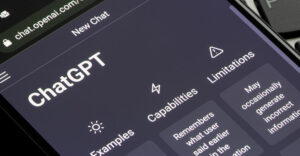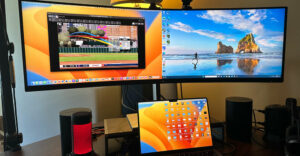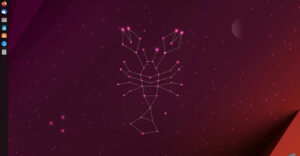Titan Linux is not an operating system that casual Linux users — especially new adopters — should install on their primary or only computer. But seasoned Linux distribution hoppers looking for a pleasant new Linux experience should not pass up the new offering.
Titan is a new distro built on the Debian Stable branch. Developers first announced its arrival on April 24. It is a very early beta release, so it is mostly bare bones. Still, it is surprisingly very stable given this phase of its development.
I looked at version 1.2 and found very few things on which to harp about its performance. The new distro’s two-person developer team has a growing community of testers for such a new project; about 60 at last count.
Typically, such small start-up teams cannot sustain forward progress and often fall by the Linux distro wayside. But I am impressed so far with this team’s accomplishments.
Project leader Matthew Moore readily admits that the new distro’s success or failure will depend on user acceptance and a supportive community. One of the bigger adoption challenges Titan Linux faces is that with no advertising or reviews yet (until now), attracting exposure of potential users is hard to achieve.
Progress and updates come almost daily. So I expect to see Titan mature more rapidly than typically happens with fledgling releases.
This distro is a fully functional yet minimal KDE Plasma desktop experience with an emphasis on usability and performance. It already has a wide range of hardware support out of the box.
Titan Linux takes a unique approach to the Debian experience. It eliminates dependency on certain meta-packages to make it a more stable system overall.
Something Old Turning Into Something New
KDE is an extensive desktop environment that offers users a plethora of customization options. It is also a Linux staple that is popular and reliable. However, KDE can turn off new users because of its complexity and its quirks.
I used KDE Plasma with numerous distros over the years. I first tried it when the old KDE desktop became a revitalized KDE Plasma upgrade. Some of its user interface (UI) issues got in my way as a daily driver.
If the direction I see Titan taking continues as it grows out of beta releases, Titan Linux with KDE could well make me a happy user again. It all comes down to usability.
Work in Progress
So far, the developers trimmed the fat out of KDE Plasma to make it less complex without the seemingly endless customization options. That is the point of this distro.
Remaining lightweight means, beside long-term simplicity, Titan can draw a larger user following with aging and less powerful computers. Keeping KDE as streamlined as possible out of the box while offering full hardware support out of the Debian catalog are welcome performance goals.
Titan Linux offers something a little more slimmed down than standard Debian. But it is more usable than a standard Debian net installation, according to Moore.
Customization is not a bad thing. Linux thrives on having the freedom to customize, tweak, and create a desktop environment suited to individual user preferences.
Part of the simplification is an innovative Titan Toolbox — a work in progress but very promising — by head developer Cobalt Rogue. This set of system management tools will let users maintain the OS with a single click. The toolbox will include a series of software apps hardwired for Titan’s specific design rather than a one-size-fits-all Debian Linux component.
Sharing Insider Views
If you like knowing how the sausage is made, check out the developer’s website for links to both Moore’s and Cobalt Rogue’s YouTube videos on the making of Titan Linux. They both provide live stream discussions of their development efforts.
It is insightful to observe the conversations that focus on team goals. A major one is not wanting Titan Linux to be just another remix. Moore has plans to grow his new distribution into a unique offering with meaningful features.
In a recent video Moore explained why he decided to build Titan Linux on Debian instead of Arch, which they previously used. That’s because Debian’s longevity between stable releases is more conducive to rapid beta releases.
Debian has long release cycles — in the neighborhood of two years — so Titan development does not break because base components change frequently. Arch distros are too erratic with rolling releases that break systems often.
Leaner KDE Planned
KDE is the moniker for the K Desktop Environment introduced in 1996. It is also a reference to the organization sponsoring development of the K desktop and the family of software that runs on its K desktop, as well as other desktops.
When the KDE community released a major upgrade from KDE 4, developers dubbed the new desktop upgrade to KDE 5 with the name “Plasma.” That name depicted the radical redesign and functionality changes as sort of a KDE rebranding.
Various Linux distros are built around the KDE project. For instance, Kubuntu Linux is a version of the Ubuntu family of OSes that uses the KDE desktop. Other popular distros running the KDE desktop environment include KaOS, Manjaro KDE, Fedora KDE Spin, MX Linux KDE, and Garuda Linux.
What makes this brand-new Titan beta OS so noteworthy to me is the potential for what it offers. It can make the K desktop more productive with streamlined features and improved usability.
Offering a stripped-down version of the KDE desktop, however, is not by itself a unique idea. Many other Linux developers have tried to rework KDE into a better-working desktop. Some even gave it a new name.
Building a Better K Desktop, Again
Few improvement attempts are distinguishable from the hundreds of Linux distributions I have reviewed over the years. Given the literally hundreds of look-alike Linux distros, reinventing KDE is rarely productive.
Few desktop environments — and Linux is both blessed and cursed with a plethora of them — can be inviting enough to fit the computing needs of all user scenarios. KDE tries to do just that.
Consider these examples:
- Feren OS toward the end of 2019 switched from the Cinnamon desktop and a Linux Mint base to KDE Plasma and the Ubuntu base.
- The KDE Neon distro — not called Plasma — is somewhat unique. It has KDE components not yet absorbed by other KDE-based distros. It is based on Ubuntu (which itself is based on Debian Linux).
- The KaOS Linux distro provides a UI-refreshed KDE-based computing platform. It offers better KDE experiences without bloated software and cumbersome usability.
- The Vector Linux family is a small, fast, and light Slackware-based distribution that ships a customized version of KDE tweaked to be more user-friendly than other Slackware-style distros.
A Glimpse of Titan’s Potential
The early beta releases of the new Titan distro are much like a partially filled outline. Sectional headings and their supporting elements are in place enough to get a solid read of the big picture.
The core parts are in place and work. But numerous blank spaces have yet to be filled in. The OS works well with what is in place. It will work even better when more innovative parts are written in.

This view of the Titan Linux desktop shows two main KDE elements — access to virtual desktops via the bottom panel and the unique activities layout accessed via a pop-out vertical left column that provides a second type of virtual computing space.

The widgets popup panel display of screen and panel apps adds a variety of services and features to the desktop layout.
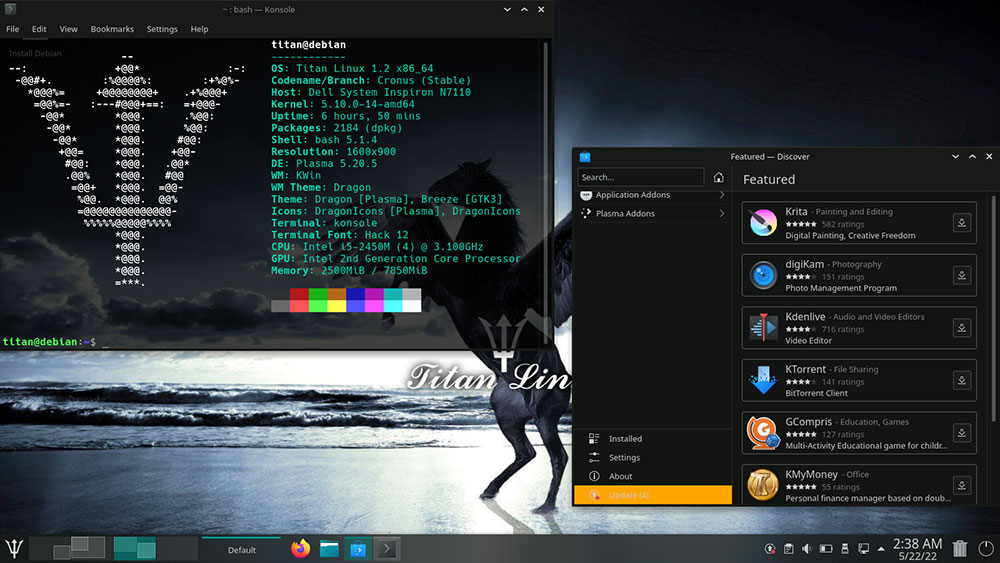
Pictured above on the left side is the terminal window’s information display along with the command line interface (CLI). On the right is the software store window which even in this early beta view provides the ability to add/remove the complete inventory of Debian Linux software.
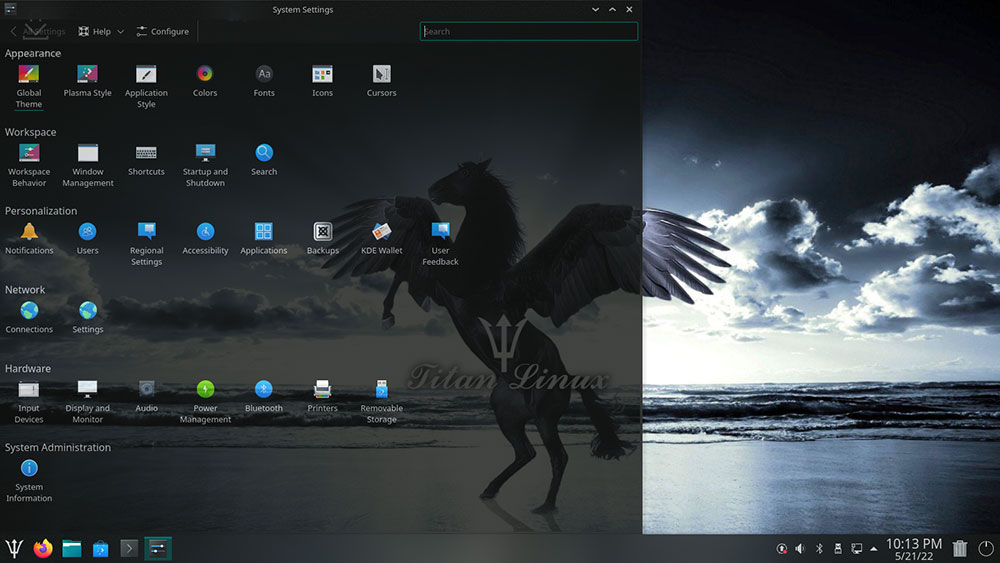
Shown here is the simplified system settings panel in Titan Linux.
Bottom Line
Titan Linux beta versions are releasing at a feverish pace. This development schedule heats up anticipation for the first stable release.
The KDE Plasma desktop design found in current Linux distros are not lightweight. Beta version 1.2 consumes 450 MB of RAM, making this anticipated new distro very lightweight. That means two things: more aging computers can find revival running the Titan OS; and new computers can outperform more standard KDE integrations.
The live session ISOs are upgraded several times per week as the developers push the envelope to release the first stable version and beyond. The live session environment lets you try out Titan Linux beta releases without making any changes to your current OS or the hard drive.
The beta version I tested performs surprisingly well already. More features and UI tweaks show up with each new ISO download.
Check it out for yourself on the Titan Linux website.
Suggest a Review
Is there a Linux software application or distro you’d like to suggest for review? Something you love or would like to get to know?
Email your ideas to me and I’ll consider them for a future column.
And use the Reader Comments feature below to provide your input!











